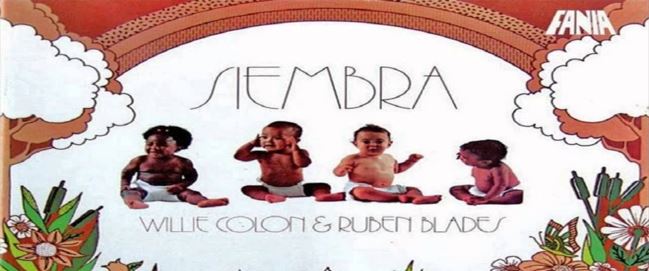This post is also available in:
 Español
Español
“Siembra”, arguably the most popular album recorded in Salsa music, turns 40 this year. In this blog, I’ll take a closer look at Willie Colon’s and Ruben Blades‘ masterpiece which redefined Salsa.
“Siembra” Redefined the Salsa Message
With “Siembra”, Willie Colon and Ruben Blades re-defined Salsa. Well, in honor of the truth, Ruben started to change the messages delivered in Salsa since their previous album “Metiendo Mano” (1977). It had songs like “Pablo Pueblo”, “Pueblo”, and “Plantacion Adentro” which provided a new social message.
As Ruben Blades explained, he wanted to use music to bring up social situations that would make people think about them. He thought the messages in Salsa music could be more than “Hey mamita, come here and let’s dance”.

But “Siembra” took the concept started in “Metiendo Mano” to the next level. Songs like “Plastico” (nicknamed “La Chica Plastica”), “Siembra”, and the legendary “Pedro Navaja” quickly penetrated a mainstream audience which included non-Salseros. The mainstream movement of Salsa penetrating a wider audience had been set in motion a couple of years earlier.
La Sonora Poncena had released Salsa songs that reached a mainstream audience like “El Pio Pio”, and “Bomba Caramboma” in 1976, and “Boranda” in 1977. Roberto Roena had released “Mi Desengano” (1976) and “Marejada Feliz” and “La Distancia” (1977).
Ruben Blades had gone mainstream himself with the Fania All Stars, with the songs “Juan Pachanga” (1976) and “Sin Tu Carino” (1978).
All the songs in “Siembra” are the type that appeal to the mainstream Latin music lover. I had rocker friends that rarely listened to Salsa which fell in love with the album “Siembra”.
Note: you can read more about the Salsa mainstream fad in the History of Salsa blog series HERE.
All Songs in “Siembra” Are Good; No Fillers
“Siembra” was one of the few albums where every single song was a good or great song. There are no fillers in this album.
Only one of the seven songs in the album wasn’t written by Ruben Blades. The beautifully insightful “Ojos” was written by the Puerto Rican song writer Johnny Ortiz.
With it, along with “Plastico”, “Buscando Guayaba”, “Pedro Navaja”, “Maria Lionsa”, “Dime”, and “Siembra”, there are no filler songs in this album.
Social Messages & Good Stories
“Siembra” and “Plastico” were Salsa songs that delivered strong social messages in a call-to-action way. They basically encouraged us to get engaged in our social issues. Not just sit or watch from the sidelines.

“Pedro Navaja” delivered a street story in such a vivid way that it didn’t matter that it was longer than the normal duration of songs played in the radio. But it wasn’t the only one.
“Buscando Guayaba” with its “solo de boca”, because Yomo Toro didn’t show up the day of the recording, also had a nice story. It was one of two songs with a romantic theme in the album. The other was “Dime”, which was more from the heartbreak side of the love equation.
Some for “Maria Lionza” and “Ojos” also brought nice stories. “Maria Lionza” brings us the story if the Venezuelan goddess worshipped by the indigenous people of the Venezuelan interior.
Note: you can read the story of Maria Lionza HERE.
In “Ojos”, Johnny Ortiz reminded us of the diverse points of view that we have in our society.
The “Siembra” Sound
Willie Colon’s band sounds really beefy in the “Siembra” recording. With Eddie “Guagua” Rivera and Salvador Cuevas sharing the bass duties, you have two masters of the instrument. Professor Joe Torres continues in the piano, although the maestro Sonny Bravo had played a couple of songs in “Metiendo Mano”. Joe has been with Willie almost from the start.
The percussion lineup was revamped from “Metiendo Mano”. In “Siembra” Jimmy Delgado takes over at timbal for Nicky Marrero. Eddie Montalvo sits on congas for Milton Cardona (who stays with Hector Lavoe). Jose Mangual, Jr. continues his decades playing with Willie Colon.
In the trombones, Papo Vazquez and Leopoldo Pineda are back, with Brazilian veteran Jose Rodrigues and Sam Burtis taking over for Lewis Kahn and Tom Malone. The latter played the Tuba in “Metiendo Mano”.
The musicians’ lineup for the album delivered the right sound. Along with arrangers like Luis “Perico” Ortiz (“Plastico” & “Pedro Navaja”), Louie Cruz (“Buscando Guayaba”, “Ojos”, & “Dime”), Carlos Franzetti (“Siembra”), and Willie Colon (“Maria Lionza”), the album was musically strong.
Most Popular Album in Salsa
With a great lineup of musicians, great musicality and sound, and a new type of messages and storytelling, “Siembra” became the most popular, and most sold album in Salsa music.
Weather it also deserves to be called the best album of all-time in Salsa music is another story. It certainly has to be in the conversation.
For these and many other reasons, “Siembra” is a landmark album in Salsa music.


[…] some 15 songs by that point, he announced they were going to play the entire music of the 1978 “Siembra” album from top to bottom, in the order of the original recording. This, as he said, would be the 1st time […]
[…] I said, Rubén Blades fans will likely find it an interesting musical proposal. Salsa fans may prefer his “Salsa […]
[…] a huge commercial success. Band leaders like Roberto Roena, Bobby Valentin, Ray Barretto, and Willie Colon had released popular hits since the last time the Fania All-Stars got together at the Red […]
[…] I said how for me it seems empty if I don’t start the Christmas holiday season playing the Willie Colón & Héctor Lavoe Salsa classic “Asalto Navideño, Vol. 1 (1971) and Vol. 2 (1972)”. […]